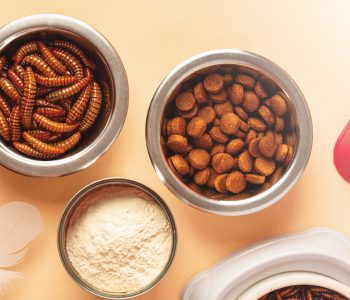These raw materials offer nutritional benefits and may also help reduce the environmental impact associated with pet food production.
Next, we will explore in more detail the role of these meals in the nutrition of dogs and cats, considering both their nutritional value and their sustainability potential.
Insect and Earthworm Meal
Studies focused on the nutrition of dogs and cats highlight the use of species such as the yellow mealworm (Tenebrio molitor), superworm (Zophobas morio), house cricket (Acheta domesticus), black soldier fly (Hermetia illucens), and tropical house cricket (Gryllodes sigillatus), due to their good nitrogen digestibility, high concentration of limiting amino acids, and potential antioxidant effects (Bosch et al., 2014; McCusker et al., 2014; Leriche et al., 2017ab; Lisenko, 2017; Kierończyk et al., 2018; Lei et al., 2019; Kilburn et al., 2020).
Moreover, insects can be excellent sources of taurine, an essential amino acid for cats, with its concentration varying by species.
In Europe, there are at least 12 insect-based dry dog foods registered, with the first one launched in 2015.
All 12 products are classified as hypoallergenic, and eight of them carry a sustainability label on their packaging (Beyne, 2018), highlighting the progress in the use of insects in canine nutrition.
Another important aspect to consider is that insects may positively influence the aroma of dog foods.
Thus, some insects may improve the palatability of diets and represent an alternative to commercial flavorings and palatability enhancers for dogs.
Like insect meals, earthworm meal also has potential for use in diets for dogs and cats. Currently, the demand for products from organic agriculture is growing.
In this context, vermiculture emerges as an interesting way to recycle organic waste in order to produce vermicompost for organic fertilization.
The earthworm biomass produced can be used in animal and human nutrition, either in its “in natura” form or for the production of earthworm meal (Ferreira, 2022).
According to Beveloni et al. (2019), Eisenia fetida meal contains about 70% protein, demonstrating its potential as a substitute for meat and bone meal (35% to 65% crude protein) or soybean meal (44% to 48% crude protein) in animal nutrition (Rostagno et al., 2017).
However, the nutritional value of earthworm meal still needs to be evaluated specifically for dogs and cats.
Hydrolyzed feather meal produced by microorganisms
Brazil is considered one of the largest exporters of chicken meat, producing 14.524 million tons in 2022 (ABPA, 2023).
Feathers account for 7% of the live animal’s body weight (Holanda, 2009) and are considered by-products of slaughter.
Since they are not edible for humans and have pollution potential if discarded in nature (Machado, 2018), their conversion into meals for animal nutrition is an effective alternative (Sinhorini, 2013).
Fresh feathers contain approximately 1% fat, 9% water, a small amount of minerals, and about 90% structural proteins, such as keratin (Machado, 2018).
Keratin contains sulfur-containing amino acids, such as cysteine, whose disulfide bridges give the protein high insolubility and low digestibility (Machado, 2018).
In contrast, keratinolytic microorganisms and their enzymes can be used for the hydrolytic processing of feathers (Said & Pietro, 2004), increasing their nutritional value (Grazziotin et al., 2006).
Final considerations
Another alternative is earthworm meal, which is also rich in proteins and essential fatty acids, but still requires studies in dogs and cats.
Additionally, considering that Brazil is a major poultry producer, feather meals could become a sustainable alternative in diet formulation, provided that their nutritional value is effectively improved through hydrolysis. They can even serve as a protein source for hypoallergenic diets.
They offer potential benefits to pet nutrition, but it is essential that more studies are conducted, especially to evaluate the long-term effects of these ingredients on the health of dogs and cats.
References available upon request.
